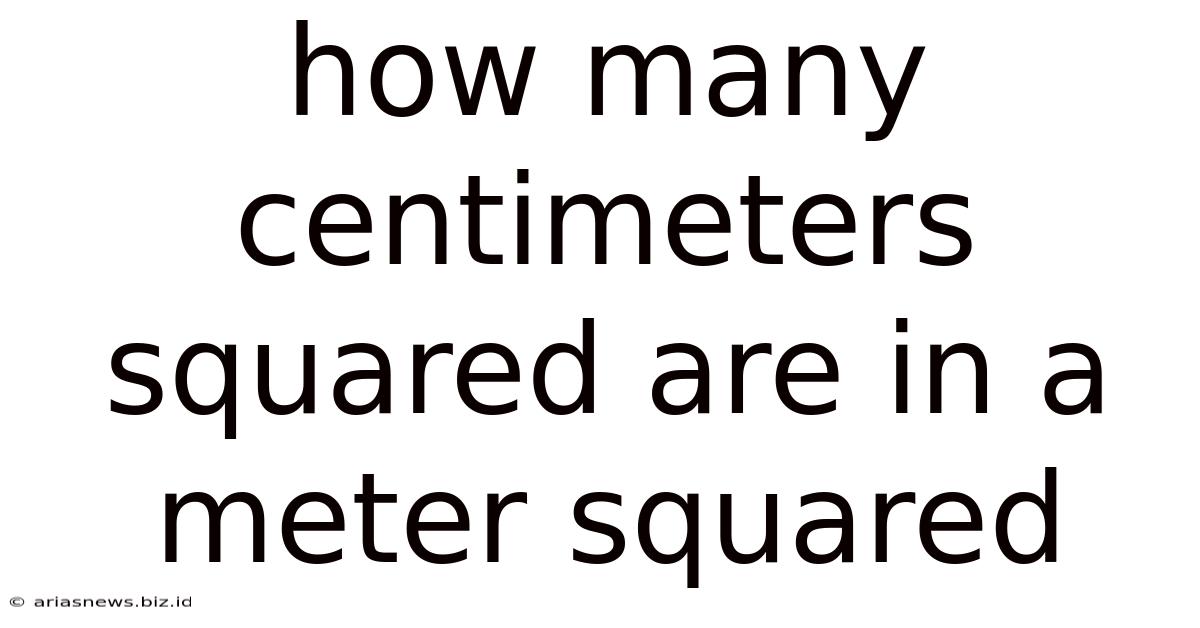How Many Centimeters Squared Are In A Meter Squared
Arias News
May 09, 2025 · 4 min read

Table of Contents
How Many Centimeters Squared are in a Meter Squared? A Comprehensive Guide
Understanding unit conversions is fundamental in various fields, from construction and engineering to everyday measurements. One common conversion that often causes confusion involves square units: specifically, how many square centimeters are in a square meter. This comprehensive guide will not only answer that question but also delve into the underlying principles, provide practical examples, and explore the broader context of metric unit conversions.
Understanding Square Units
Before diving into the conversion, let's solidify our understanding of square units. A square unit represents the area of a square with sides of a specific unit length. For instance:
- Square centimeter (cm²): The area of a square with sides measuring 1 centimeter each.
- Square meter (m²): The area of a square with sides measuring 1 meter each.
The key difference lies in the scale. A meter is significantly larger than a centimeter; specifically, there are 100 centimeters in 1 meter (1m = 100cm). This difference in linear measurement has a profound effect on the corresponding square units.
The Conversion: Centimeters Squared to Meters Squared
The conversion from square centimeters to square meters isn't simply multiplying by 100. Because we're dealing with area, which is two-dimensional, the conversion factor needs to be squared as well.
Here's the breakdown:
-
Relationship between centimeters and meters: 1 meter = 100 centimeters (1m = 100cm)
-
Squaring the relationship: To find the relationship between square centimeters and square meters, we square both sides of the equation: (1m)² = (100cm)²
-
Result: This simplifies to 1m² = 10,000cm².
Therefore, there are 10,000 square centimeters (cm²) in 1 square meter (m²). This is a crucial conversion factor to remember.
Practical Applications and Examples
Let's illustrate this conversion with some practical examples to reinforce understanding:
Example 1: Calculating the area of a room.
Imagine a rectangular room measuring 5 meters by 4 meters. To find the area in square meters, we multiply the length and width: 5m * 4m = 20m².
Now, let's convert this area to square centimeters:
20m² * 10,000cm²/m² = 200,000cm²
The room has an area of 20 square meters, which is equivalent to 200,000 square centimeters.
Example 2: Converting a smaller area.
Suppose you have a piece of paper measuring 20 centimeters by 30 centimeters. Its area in square centimeters is: 20cm * 30cm = 600cm².
To convert this to square meters, we divide by the conversion factor:
600cm² / 10,000cm²/m² = 0.06m²
The paper has an area of 600 square centimeters, which is equivalent to 0.06 square meters.
Beyond the Basics: Exploring Other Metric Conversions
Understanding the conversion between square centimeters and square meters lays the groundwork for understanding other metric conversions involving area. Let's briefly explore some related concepts:
-
Square millimeters (mm²): Since 1cm = 10mm, 1cm² = 100mm². This means there are 100 square millimeters in one square centimeter.
-
Square kilometers (km²): Since 1km = 1000m, 1km² = 1,000,000m². This signifies that there are one million square meters in one square kilometer.
-
Hectare (ha): A hectare is a unit of area commonly used in land measurement. One hectare is equal to 10,000 square meters (1ha = 10,000m²).
Mastering these conversions empowers you to seamlessly navigate various measurement scenarios.
Tips for Accurate Conversions
To avoid errors when converting between square units, consider these tips:
-
Clearly identify the units: Always double-check the units you're working with (cm², m², etc.) to ensure consistency.
-
Use the correct conversion factor: Remember the key conversion: 1m² = 10,000cm².
-
Break down complex problems: For more intricate calculations, break down the problem into smaller, manageable steps.
-
Check your work: After completing a conversion, take a moment to review your calculations to identify any potential mistakes.
The Importance of Understanding Unit Conversions
Understanding unit conversions is crucial for several reasons:
-
Accurate calculations: Incorrect conversions can lead to significant errors in various applications, from construction projects to scientific experiments.
-
Effective communication: Using consistent units ensures clear and unambiguous communication among professionals and individuals.
-
Problem-solving abilities: Mastering unit conversions enhances your overall problem-solving skills, translating to success in various fields.
-
Data analysis: Accurate unit conversions are essential for proper interpretation and analysis of data.
Conclusion: Mastering Square Unit Conversions
The conversion from square centimeters to square meters, while seemingly simple, underscores the importance of understanding the relationship between linear and square units. By grasping this fundamental conversion and the broader principles of metric conversions, you'll enhance your ability to tackle a wide range of measurement challenges efficiently and accurately. Remember the key takeaway: 1m² = 10,000cm². With practice and consistent application, unit conversions will become second nature. This improved understanding will benefit you in both professional and personal endeavors. So, whether you're measuring the area of a room, calculating the size of a land plot, or working on a complex engineering project, mastering these conversions is invaluable.
Latest Posts
Latest Posts
-
What Can Be Defined As An Information Technology Environment
May 10, 2025
-
What Is The Alcohol Percentage Of Bud Light
May 10, 2025
-
Distance From St Louis To Branson Mo
May 10, 2025
-
John Adams Virtual High School Transcript Request
May 10, 2025
-
Why Do Horses Stand Head To Tail
May 10, 2025
Related Post
Thank you for visiting our website which covers about How Many Centimeters Squared Are In A Meter Squared . We hope the information provided has been useful to you. Feel free to contact us if you have any questions or need further assistance. See you next time and don't miss to bookmark.